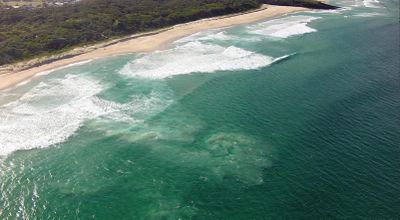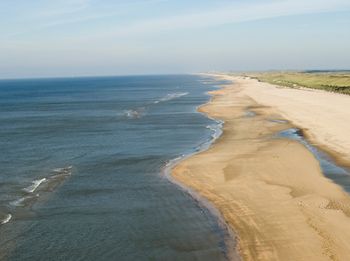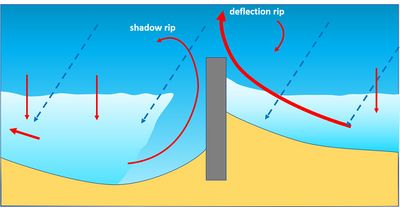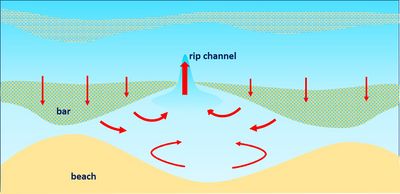Rip current
Definition of Rip current:
Rip currents are wave-generated currents that depart from the nearshore zone in offshore direction.
This is the common definition for Rip current, other definitions can be discussed in the article
|
The above general definition includes a wide family of currents. It includes, for example, a longshore current that separates from the shore at a strong curvature of the shoreline. A more restricted definition of a rip current is:
a narrow offshore directed jet flow generated by a local imbalance between wave-induced radiation stress and sea level set-up at the coast.
We mainly focus on rip currents according to this restricted definition.
Rip currents are the prime cause of drowning among beachgoers and contribute to the loss of sand from the active coastal zone. Rip currents can occur on any coast where the wave breaker location varies alongshore. Rip-current activity typically increases with a shore-normal wave incidence, higher wave height, longer wave period, and lower tide level.
Contents
Morphodynamic rips
Numerous different morphological patterns can arise in the surf zone as a result of morphodynamic feedback processes, as described in the article Rhythmic shoreline features. Rip cells are one member of this large family of self-organized surf zone patterns. Morphodynamic rips often emerge when incident waves break over a submerged nearshore bar and transfer part of their wave orbital momentum to a net onshore directed stress (radiation stress) that raises the water level between the bar and the beach. On a perfectly longshore uniform coast the radiation stress and the water level slope would be exactly in balance. However, as uniformity is not perfect in nature, deviations from the balance do locally occur. The local imbalances between radiation stress and water set-up generate currents that are shoreward directed where the radiation stress is stronger and seaward directed where the radiation stress is weaker. These cross-shore currents form circulation cells that strengthen and consolidate the hydrodynamic imbalances by imprinting the rip flow circulation in the nearshore bathymetry: (1) a rip channel is scoured at the location of dominant seaward flow, in which the seaward rip flow is concentrated; (2) a beach embayment is scoured opposite to the rip channel, where the least broken waves hit the beach; (3) onshore horns are accreted at the inner bar where the waves are attenuated most strongly. This positive morphodynamic feedback and the corresponding bathymetry and flow circulations are schematically displayed in Fig. 1. The presence of rip currents in the field is illustrated for two different beaches in Fig. 2 and 3. The rips are situated between the zones where waves are breaking on the nearshore sandbar.
 Rip currents at Burrill Beach, South Coast NSW, Australia. The strength of the current is illustrated by the offshore plume of sediment that is stirred up from the seabed. The beach facing the rip is most exposed to wave breaking. Photo credit Daryl Gama. https://www.scienceofthesurf.com/ |
 Rip cell at the barred coast of North Holland, The Netherlands. Photo credit Rens Jacobs https://beeldbank.rws.nl/ |
Channel rips arise on a barred sandy shoreface under moderate wave conditions when the direction of incident waves is close to shore-normal. The rip-channel bathymetry persists under such conditions, but disappears when the nearshore sandbars are straightened by highly energetic, obliquely incident waves. In case of oblique wave incidence the rip cell pattern travels slowly in the direction of the littoral drift. Morphodynamic rips usually have a regular spacing along the coast with wavelengths in the range 50 to 500 meters[1]. Wave refraction, wave breaking and associated radiation stress in the rip channel oppose rip flow strengthening. This negative feedback is thought to be responsible for the often observed pulsating character of the rip flow[2].
Rip currents at low tide are usually stronger than at high tide. A possible explanation is that during low water, hydrodynamic processes are more strongly influenced by depth effects, and in particular the presence of a bar-trough morphology with rip channels. This type of bathymetry often develops after storms, when a storm-built bar migrates back onshore. A more frequent occurrence of morphodynamic rips can thus be expected during such periods[3] .
Boundary rips

Boundary rips are related to the presence of hard topographic structures (headlands, groynes, jetties) that locally shield the beach from obliquely incident waves. In the wave shadow zones the radiation stress is not in balance with the wave set-up at the beach. The excess pressure of the wave set-up generates a rip current that runs along the structure - a so-called shadow rip. The seaward rip flow is mainly recirculated by the onshore flow in the breaker zone[5].
The oblique wave incidence also generates a longshore current that causes accretion at the updrift side of the structure and erosion at the downdrift side. The longshore current at the updrift side is deflected offshore by the structure. This deflected current is called a deflection rip. It can extend far offshore, up to a few times the surf zone width[6]. The shadow rip and deflection rip are schematically depicted in Fig. 4.
The offshore extent of a deflection rip current depends in particular on the relative groyne length (ratio of groyne length to surf zone width). Short groynes (relative length < 1) produce strong deflection rips, but they remain contained in the surf zone, while the deflection rips of long groynes are weaker but can reach far offshore. These offshore rip flows along groynes can be a significant conduit for transporting sediment offshore, especially in cases of high waves with strong oblique incidence [7].
Other rip types
According to the more general definition several other mechanisms can produce rip currents.
One type of rip current is related with the presence of bathymetric features outside the surf zone, such as rocky outcrops, submarine canyons, offshore shore-parallel breakwaters, or an island near the coast. Such features perturb the alongshore uniformity of the incident wave field and the uniformity of mean water levels at the beach, by wave shielding effects, by affecting local wave dissipation, or by creating specific wave diffraction and refraction patterns. Perturbation of longshore uniformity induces rip currents that can become channelized. However, unlike morphodynamic rips, the channels are not self-organizing with alongshore periodicity. The presence and strength of these forced rip currents depend strongly on offshore wave conditions[8].
Rip currents can also develop without morphodynamic interaction. These rip currents are known in the literature under various names: transient rips, hydrodynamic rips, or flash rips. They are unpredictable, episodic (lasting on the order of 15 minutes), or quasi-periodic, and tend to move along the beach. Transient rip currents can occur on beaches with both oblique and normal wave incidence. The driving mechanism is not yet fully elucidated. There are indications that flash rips are associated with flow vorticity generated by shear instability of the alongshore current or by temporal and spatial alongshore non-uniformity of the wave breaking process[5]. The simplest type of transient rip current could be the one formed at the intersection nodes of wave trains generated by regular waves with the same wave period and slightly different wave directions[9]. Transient rip currents generally have smaller offshore flow and offshore extent than their morphodynamically controlled counterparts, but are still hazardous to beachgoers.
Relevance of rip currents
- Rip currents are dangerous for swimmers and are the major cause of swimming accidents and casualties
- Rip currents can accelerate coastal erosion by transporting beach sand offshore, especially in the presence of structures such as groynes
- Rip currents contribute to the mixing and flushing of nearshore waters and to the regulation of nearshore water quality[10]
- Rip currents contribute to the exchange of organisms between nearshore and offshore waters
Recommended reviews on rip currents
- Castelle, B., Scott, T., Brander, R.W. and McCarroll, R.J. 2016. Rip current types, circulation and hazard. Earth Science Reviews 163: 1–21
- MacMahan, J.H., Reniers, A.J.H.M., Thornton, E.B. and Stanton, T.P. 2004. Surf zone eddies coupled with rip current morphology. Journal of Geophysical Research 109, C07004
- Largier, J.L. 2022. Rip Currents and the Influence of Morphology on Wave-Driven Cross-Shore Circulation. Ch. 8.05. Treatise on Geomorphology, 2nd edition, Volume 8. Elsevier.
- Recommended website: https://www.scienceofthesurf.com/
Related articles
References
- ↑ Short, A.D. and Brander, R.W. 1999. Regional variations in rip density. J. Coast. Res. 15: 813–822
- ↑ MacMahan, J.H., Reniers, A.J.H.M., Thornton, E.B. and Stanton, T.P. 2004. Surf zone eddies coupled with rip current morphology. Journal of Geophysical Research 109, C07004
- ↑ Dalrymple, R.A., MacMahan, J.H., Reniers, A.J.H.M. and Nelko, V. 2011. Rip currents. Annu. Rev. Fluid Mech. 43: 551–581
- ↑ Sous, D., Castelle, B., Mouragues, A. and Bonneton, P. 2020. Field Measurements of a High-Energy Headland Deflection Rip Current: Tidal Modulation, Very Low Frequency Pulsation and Vertical Structure. J. Mar. Sci. Eng. 8(7), 534
- ↑ 5.0 5.1 Castelle, B., Scott, T., Brander, R.W. and McCarroll, R.J. 2016. Rip current types, circulation and hazard. Earth Science Reviews 163: 1–21
- ↑ McCarroll, R.J., Brander, R.W., Turner, I.L., Power, H.E. and Mortlock, T.R. 2014. Lagrangian observations of circulation on an embayed beach with headland rip currents. Mar. Geol. 355: 173–18
- ↑ Scott, T., Austin, M., Masselink, G. and Russell, P. 2016. Dynamics of rip currents associated with groynes — field measurements, modelling and implications for beach safety. Coastal Engineering 107: 53–69
- ↑ Long, J. and Özkan-Haller, H. 2016. Forcing and variability of nonstationary rip currents. J. Geophys. Res. 121: 520–539
- ↑ Dalrymple, R.A. 1975. A mechanism for rip current generation on an open coast. J. Geophys. Res. 80: 3485–87
- ↑ Largier, J.L. 2022. Rip Currents and the Influence of Morphology on Wave-Driven Cross-Shore Circulation. Ch. 8.05. Treatise on Geomorphology, 2nd edition, Volume 8. Elsevier
Please note that others may also have edited the contents of this article.
|
